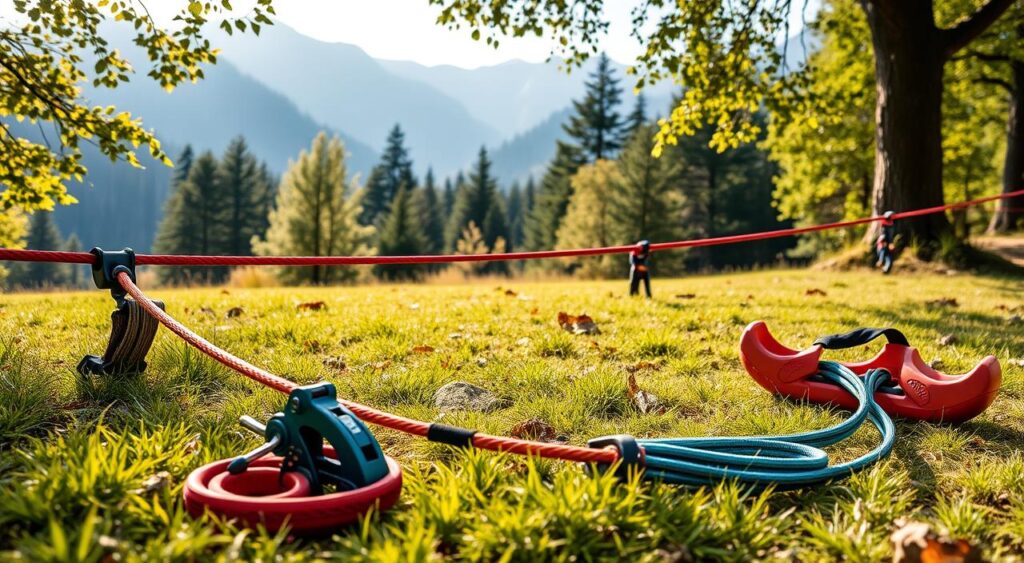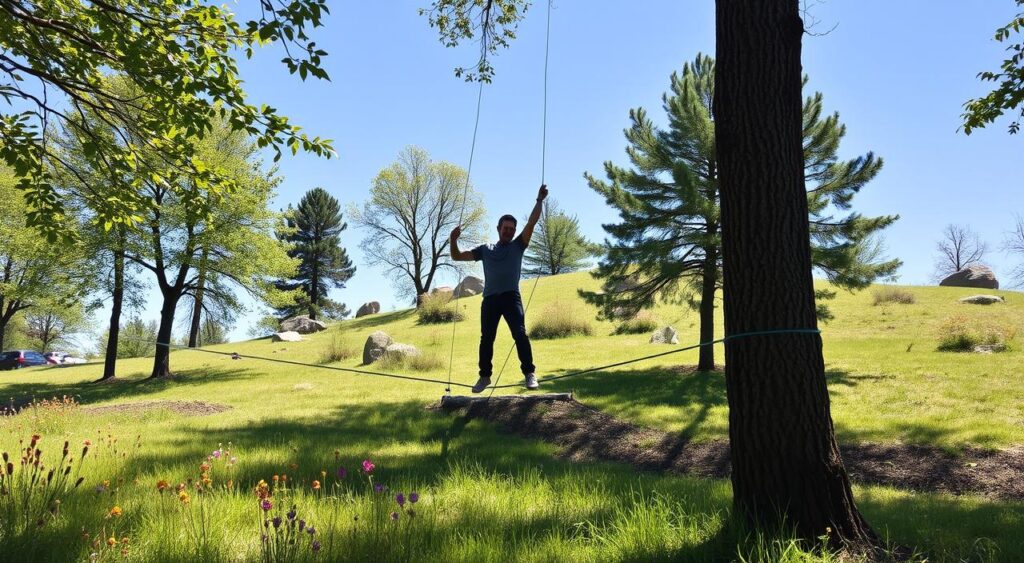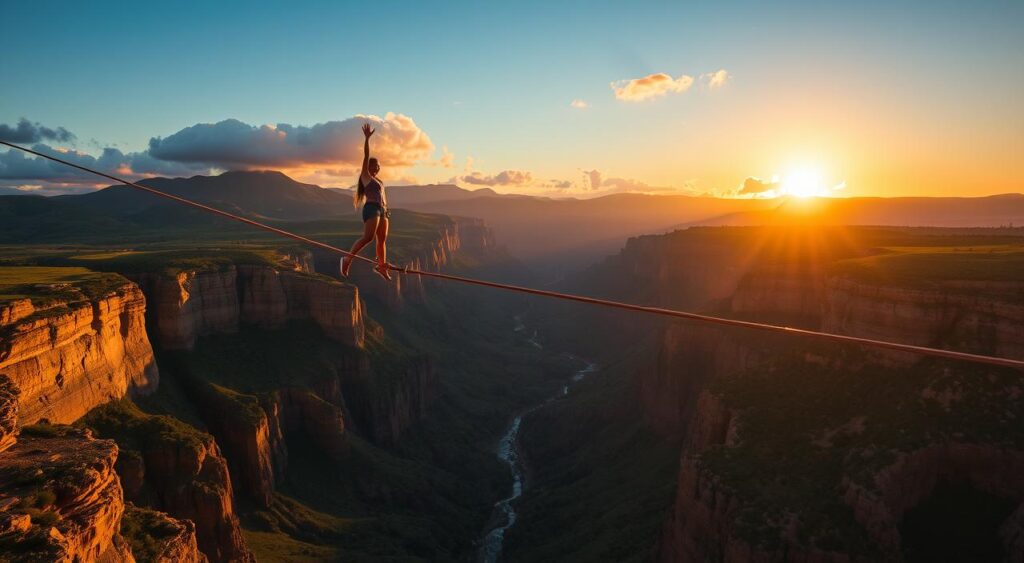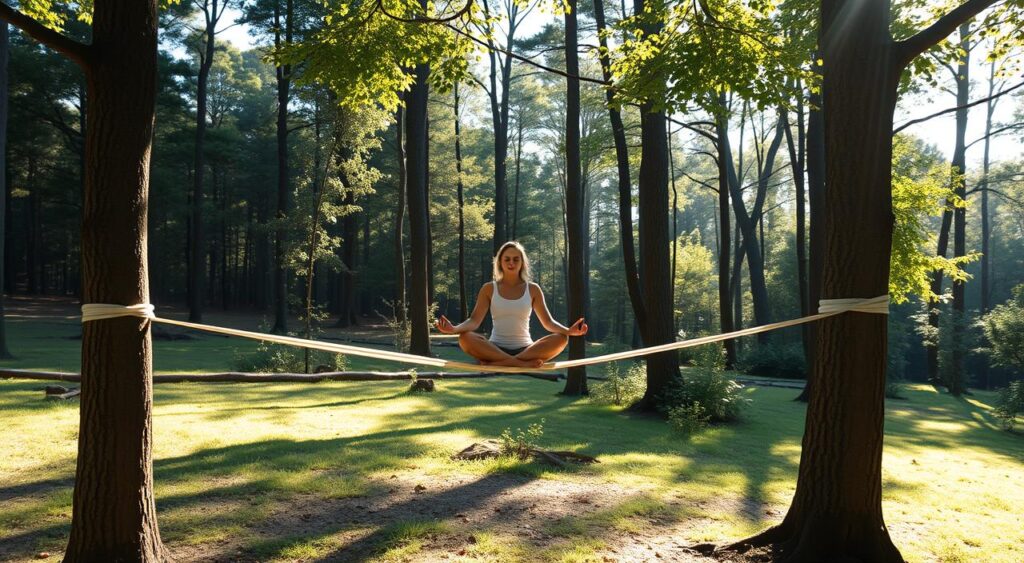Slacklining is a thrilling outdoor activity that tests your balance, strength, and courage. It’s about walking, running, or doing acrobatics on a thin, tight webbing between two points. Often, these points are high up in the air. This sport has become popular for its challenge and the joy of being outdoors.
This article will cover the basics of slacklining. You’ll learn about the gear you need and advanced techniques. It aims to inspire you to try this exciting sport.
Table of Contents
What is Slacklining?
Slack-lining is an exciting outdoor activity that tests your balance, strength, and connection with nature. It’s about walking, running, or doing tricks on a thin, tight webbing between two points. These points are often high up, making it a thrilling challenge.
Slack-lining requires you to use your core strength, coordination, and focus. It’s a mix of physical and mental effort that’s both captivating and rewarding.
Slack-lining: A Unique Blend of Balance, Strength, and Adventure
Learning to balance on the slackline gives you a sense of freedom and achievement. It’s a sport that needs both physical and mental skills. You must adjust your body to stay balanced on the moving line.
It’s a workout for your core, coordination, and focus. Slacklining is a special outdoor activity that offers a unique challenge and reward.
The Origins and Evolution of Slack-lining
Slack-lining started in the 1970s with climbers and outdoor lovers using webbing for balance training. It was mainly for climbers to get better at balance and strength. But it has grown a lot since then.
Now, slack-lining has its own gear, techniques, and a big community of slackliners. It’s not just for climbers anymore. People from all walks of life enjoy the challenge, adventure, and calm it brings.
“Slacklining is a unique blend of physical and mental challenge, allowing me to connect with nature in a profoundly personal way.”
– John Doe, avid slackliner
Essential Slacklining Gear

Starting your slack-lining adventure needs the right gear. At the core is the slackline, a webbing or strap stretched between two points. It’s where you’ll improve your balance and agility.
Key slack-lining gear also includes a harness, carabiners, and a way to adjust the line’s tightness. These items ensure your safety and comfort as you challenge your balance and coordination.
Wearing protective gear like helmets and pads is smart, especially at high places or for tough moves. It helps reduce risks and lets you explore with more confidence.
Choosing the right slackline equipment makes your experience better. Quality outdoor gear lets you focus on improving and enjoying the thrill of this activity.
| Slack-lining Gear | Description | Importance |
|---|---|---|
| Slackline | A specialized webbing or flat nylon/polyester strap | The foundation of the slack-lining setup |
| Harness | Secure attachment point for safety and control | Crucial for safety and stability |
| Carabiners | Sturdy metal clips for connecting gear | Essential for securing the slackline and harness |
| Tensioning System | Mechanism to adjust the tightness of the slackline | Allows for customization and optimal performance |
| Protective Gear | Helmets, pads, and other safety equipment | Enhances safety and confidence for advanced maneuvers |
With the right slack-lining gear, you’re ready to start your journey. You’ll be safe, confident, and able to challenge yourself and discover new skills.
Mastering the Basics

Getting good at slack-lining starts with a solid foundation. As a beginner, focus on standing steady on the line. Place your feet shoulder-width apart, bend your knees slightly, and balance your weight evenly. Try different hand positions to see what feels right for you.
With regular practice and patience, you’ll get better at controlling your body on the slackline. This will help you move confidently across it.
Stance and Body Positioning for Beginners
Keeping the right stance and body position is key for slack-lining. Stand with your feet shoulder-width apart, knees slightly bent, and your weight evenly distributed. Keep your core tight and your arms out for balance.
Experiment with hand positions to find what works best for you. This will help you stay stable and comfortable.
Developing Core Strength and Balance
Slack-lining needs strong core and balance skills. You can build these through training and practice. Do exercises like planks, leg raises, and squats to strengthen your muscles.
Also, practice balance exercises like standing on one leg. This will improve your body awareness and balance. Regular training will help you get better at slack-lining.
| Slack-lining Basics | Techniques |
|---|---|
| Stance and Body Positioning | Developing Core Strength and Balance |
| – Shoulder-width stance – Knees slightly bent – Evenly distributed weight | – Planks – Leg raises – Squats – Balance exercises |
“Slack-lining requires a high level of core strength and balance, which can be developed through dedicated training and practice.”
Slack-lining for Outdoor Adventure

Slack-lining is an exciting outdoor activity that takes you to new heights. Highlining is a thrilling part of this sport. It involves walking on a tight line high above the ground.
This sport requires balance, skill, and a deep respect for safety. Those who try highlining feel a strong connection with nature. They also feel a great sense of achievement as they cross the line.
Embracing the Thrill of Heights
Highlining is an extreme sport that tests your balance, strength, and courage. Walking on a thin line high up requires focus, stability, and facing your fears. The feeling of crossing a highline is unmatched in many outdoor activities.
Highlining leaves a lasting impression, whether you’re experienced or new. As you step onto the line, the world below disappears. You’re left with the sky, the line, and your determination to explore new limits.
Slacklining for Fitness and Mindfulness

Slack-lining is a fun way to boost your fitness and mental health. It works your core, legs, and balance muscles, making them stronger. It’s great for cardio, strength, and even helping with injuries.
It also improves your balance, coordination, and agility. This makes it a great part of any fitness plan.
Incorporating Slacklining into Your Workout Routine
Slack-lining is a great addition to your workouts. It helps with core strength, balance training, and overall slack-lining fitness. You can do simple poses or more complex moves, depending on your level.
The Meditative Aspects of Slacklining
Slack-lining also improves your mental health and mindfulness. Balancing on the line requires focus and being in the moment. It can make you feel calm and peaceful.
Many people find it helps reduce stress and makes them appreciate the present. It’s a great way to practice meditation and grow personally.
“Balans är en nödvändig komponent inom alla rörelsebaserade sporter och aktiviteter, och för vardagliga sysslor som gå, stå upp eller sitta i en stol. Balanseringsförmågan kan förbättras genom övning, likt styrka och uthållighet.”
Progressing to Advanced Techniques
As you get better at slack-lining, you’ll find joy in learning new tricks and combos. You can start with simple moves like walking backward or doing pirouettes. Then, you can move on to more complex stunts like jumps, flips, and spins.
Mastering these advanced moves takes a lot of practice. You need to understand balance, control your body, and feel the line’s movements. Slackliners who work hard on these skills feel a great sense of achievement. They also get to see how far they can push the limits of the slackline.
Mastering Tricks and Combos on the Slackline
To improve your slack-lining, try adding these advanced techniques to your routine:
- Backward Walking – Try walking backward on the line. Keep your core tight and your movements smooth.
- Pirouettes – Spin on the line to show off your agility and balance. Move in a smooth, controlled way.
- Jumps and Leaps – Show off your athleticism with dynamic jumps, flips, and spins. Take your slack-lining to new levels.
- Handstands and Inversions – Try handstands, cartwheels, and other inverted moves. They show your strength and core stability.
Remember, mastering these slack-lining tricks and advanced techniques takes time and effort. Be patient and always keep learning. Let your slack-lining skills reach new heights.
Slacklining Community and Events
The slack-lining community is full of people who love the sport. They meet up to share their passion and learn from each other. There are regular meetups, workshops, and competitions for all skill levels.
These events include demonstrations, skill-building clinics, and social gatherings. They help create a sense of friendship and shared adventure in the slack-lining community. Joining these slack-lining events is a great way to dive into the sport, improve your skills, and meet others who share your interests.
Balancing is key in sports and activities that involve movement. You can get better at balancing with practice, just like you would with strength and endurance. Static balance exercises help train balance and strength, while dynamic balance exercises with steps and jumps improve dynamic balance.
Slack-lining is great for both static and dynamic balance. You’ll need a soft slackline, flat-soled shoes, and focus to do it well. By taking part in these outdoor recreation activities, you can improve your balance and connect more with the slack-lining community.
| Slack-lining Event | Location | Date |
|---|---|---|
| Slackline World Cup | Lagos, Nigeria | December 31, 2023 |
| Slackline Fest | San Francisco, USA | June 15-17, 2023 |
| Slackline Challenge | Sydney, Australia | October 20-22, 2023 |
The slack-lining community is a vibrant and supportive network. It fosters camaraderie and shared exploration. By joining local and regional slack-lining events, you can dive into the sport, grow your skills, and meet others who share your passion. Whether you’re new to slack-lining or have been doing it for years, these events are a great way to learn, grow, and celebrate the outdoor recreation of slack-lining.
Inspiring Slack-lining Feats and Records
Slack-lining is a world where people test their limits. Jaan Roose, an Estonian slackliner, has made a big mark. He’s known for his slack-lining feats and slack-lining records.
Jaan Roose is now at the pinnacle of the sport. He has numerous world championship titles under his belt. He has a large following thanks to his talent and inventiveness.
Jaan Roose: The Visionary Pushing Slack-lining Boundaries
Jaan Roose is a true leader in slack-lining. He’s always ready to take on new challenges. His work has changed the sport and inspired many.
“Jaan Roose’s relentless pursuit of passion and personal growth has made him a true inspiration to the slacklining community.”
Roose’s story shows us what we can achieve. His success inspires others to try new things. It shows the power of slacklining to change lives.
Jaan Roose has made a lasting impact on slacklining. His hard work, creativity, and spirit inspire people all over the world.
Conclusion
Slacklining is a thrilling outdoor activity that combines physical challenge, mental focus, and a deep connection with nature. It’s great for improving balance, boosting fitness, or exploring its meditative aspects. By learning the basics, embracing outdoor adventures, and joining the slacklining community, you start a journey of personal growth.
The history of slacklining began in the late 1970s. It has since seen record-breaking feats by athletes like Jaan Roose. This sport enhances balance training, fitness, and mindfulness. It has attracted fans worldwide, leading to exciting festivals and events.
So, take the first step and step onto the line. Discover the endless possibilities of this captivating sport. Whether you’re looking for a new challenge, a transformative workout, or a deeper connection with nature, slacklining has it all. Embrace the adventure, improve your skills, and join the passionate slacklining community.
